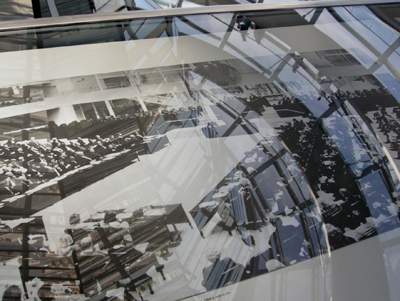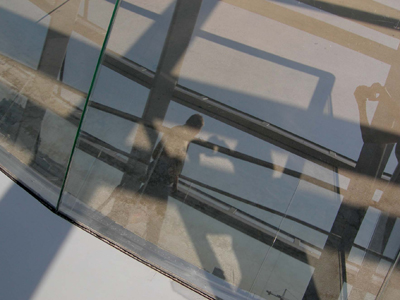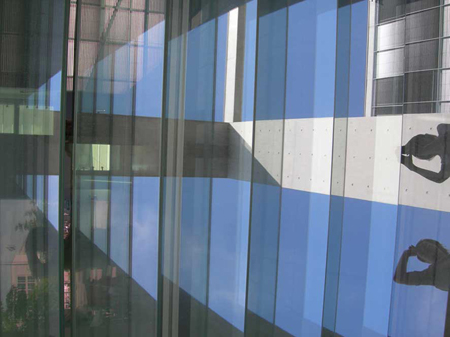Aleksander Komarov – On Translation: Transparency/Architecture Acoustique
*** English version below ***
Eröffnung Freitag, 29. Februar 2008, 19 Uhr
Laufzeit 1. – 30. März 2008
Finissage Sonntag, 30. März 2008, 18 Uhr
Die Ausstellung On Translation: Transparency/Architecture Acoustique des Künstlers Aleksander Komarov (*1971 in Grodno, Weißrussland, lebt seit 2000 in Rotterdam, Niederlande) ist nicht nur die erste Einzelpräsentation des Künstlers in Deutschland, sondern eröffnet auch eine Reihe im Weddinger Projektraum uqbar, die sich mit Raumkonzepten und zeitgenössischer Architektur auseinandersetzt.
Die Videoinstallation On Translation: Transparency/Architecture Acoustique wurde ursprünglich für die 10. Istanbul Biennale (2007) entwickelt. Im Zentrum der Arbeit steht der Begriff der Transparenz, dessen Bedeutung und Wandel der Künstler versucht aus verschiedenen Perspektiven zu beleuchten. Hauptelement der Installation ist ein dreiteiliger, je 10 Minuten umfassender Film, in dem Komarov Aufnahmen der Glasfassade der Van Nelle Fabrik in Rotterdam und der Glaskuppel des Berliner Reichstagsgebäudes gegenüber stellt. Die beiden Orte stehen für unterschiedliche architektonische Konzepte und Umgangsweisen mit Transparenz. Die Van Nelle Fabrik (1926–30) ist ein typisch modernistischer Bau in Glas und Stahl. Die Berliner Reichstagskuppel steht für einen eher symbolischen Umgang mit Transparenz, mit dem der demokratische Prozess der politischen Partizipation zur Schau gestellt werden soll. Die Besucher können durch die Glaskuppel hindurch dem Parlament bei seinen Sitzungen zusehen. Komarovs Film zeigt aber auch, welche Mühen es kostet, diese Illusion aufrecht zu erhalten. In einer Einstellung sieht man ein Team von Fensterputzern bei dem kontinuierlichen Versuch, das Glas möglichst klar und sauber zu halten und so die Glaswand zwischen Staatsmacht und Bürger möglichst unsichtbar zu machen, diese zu dematerialisieren. Auf visueller Ebene reiht der Künstler fotografische Einstellungen von Spiegelungen und Reflexionen aneinander, die den Blick von den Gebäuden weg auf ihre Umgebung richten. Dabei erscheinen die Glasflächen weniger durchsichtig, sondern vielmehr als Projektionsflächen, in denen sich sowohl die Umwelt wie auch die Besucher und ihre Vorstellungen spiegeln. Diese Bilder hat der Künstler von verschiedenen Komponisten vertonen lassen. Die einzelnen Kompositionen strukturieren die Videoarbeit in drei Teile, die sich hauptsächlich durch ihre unterschiedlichen Klangebenen unterscheiden. Der erste Teil zeigt die Bilder mit dem ursprünglichen Ton, im zweiten Teil hat Gleb Shutov den Originalton in Noten rückübersetzt und der dritte Teil ist mit einer frei-assoziativen Komposition von Elvira Plenar unterlegt.
In der Ausstellung wird der Film auf einen transparenten Screen projiziert und von einer roten LED-Laufschrift ergänzt, auf der Auszüge aus einem Interview Komarovs mit dem Architekturtheoretiker Carl Zillich zu lesen sind. Das Interview, das zudem in einer Publikation zum Mitnehmen nachzulesen ist, legt die theoretischen Überlegungen offen, auf denen das künstlerische Projekt basiert.
Videostills aus On Translation: Transparency/Architecture Acoustique
Opening Friday, February 29, 2008, 7 p.m.
Duration March 1 – 30, 2008
Finissage Sunday, March 30, 2008, 6 p.m.
The exhibition On Translation: Transparency/Architecture Acoustique is not only the the first solo presentation in Germany of the artist Aleksander Komarov (*1971 in Grodno, Bielorussia, lives in Rotterdam since 2000), but also the first of a series of exhibitions on spatial concepts and contemporary architecture taking place at uqbar project space in 2008. The video installation On Translation: Transparency/Architecture Acoustique was originally designed for the 10th Interntional Istanbul Biennial (2007). At the core of the work is the concept of transparency. The artist highlights the meaning, implications and historic change of the term from different perspectives. Main element of the installation is a film in three parts, each of them 10 minutes long, in which Komarov opposes shots of the glass facade of the Van Nelle factory in Rotterdam with shots of the glass cupola of Berlin's Reichstag building. The two places represent different architectural concepts and ways of dealing with transparency. The Van Nelle factory (1926–30) is a typical modernist building in glass and steel. The Berlin Reichstag cupola stands for a more symbolic use of transparency in its attempt of making the democratic process of political participation visible. Through the glass of the dome in fact the visitors can see the Parliament at its meetings. At the same time Komarov’s film shows what effort it costs to maintain the illusion of transparency. In one sequence one can see a team of window cleaners at work, continously attempting to clear the glass, to keep it clean, and hence to dematerialize the glass wall between the State power and the citizens. On the visual level the artist juxtaposes photographic shots of reflections, which direct the gaze away from the buildings on to their environment. Thus, the glass surfaces appear less transparent but more as a projection surface that reflects the environment as well as the visitors and their ideas. The artist asked different composers to set these images to music. The sound compositions structure the film in three parts. Each part shows almost the same images accompanied by a different soundtrack, causing a shift in the perception. The first part shows the images with the original sound, for the second part Gleb Shutov re-translated the original sound in notes, and the third part is combined with a free-associative composition of Elvira Plenar.
In the exhibition at uqbar the film is projected on a transparent screen, flanked by a red LED ticker that displays excerpts from an interview by Aleksander Komarov with the architect and theorist Carl Zillich. The interview, also available in the show as a free hand publication, reveals the theoretical and aesthetic considerations the project is based on.
Video stills from On Translation: Transparency/Architecture Acoustique


